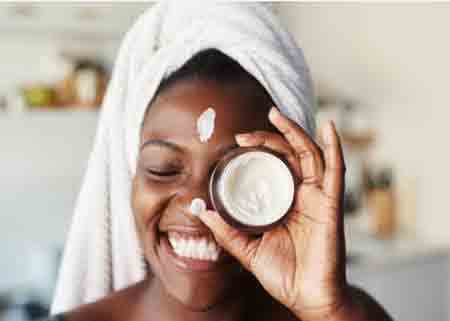The face is the calling card of every woman. Beautiful and well-groomed skin makes us feel confident and attractive.
It is a mistake to think that to maintain a good appearance, it is only necessary to visit a beautician regularly, and the rest of the time, a wash and a simple cream are enough.
Many women make serious mistakes even in simple daily facial treatments. But only with the proper Bloommy collagen face cream care can keep the beauty and youthfulness of the skin for many years.

Facial care is a whole ritual, the importance of which can not be overestimated. With the adequately built system, daily care turns into a 10-minute pleasure in the morning and the evening, and the result will not make you wait long.
The right approach to facial care always begins with determining your skin type. This is necessary to choose the right cosmetics.
For example, oily and dry skin remedies are very different, and the wrong approach can lead to negative consequences.
There are four skin types – normal, oily, dry, and combined. Stages for skincare are the same for all kinds, the only individual cosmetic products for these procedures, for selecting which is initially better to contact a cosmetologist.
Daily home care for facial skin involves the following basic steps:
- Cleansing
- Toning
- Primary care (moisturizing and nourishing) 4.
- Complementary care
- Protection.
Also, don’t forget that glycolic acid and vitamin C should be present in your skincare routine.
Regular glycolic acid and vitamin C gradually clears the skin of comedones – plugs composed of sebum and solitary epidermal cells.
As a result, enlarged pores are less visible, and skin texture improves.
Observance of each step is an integral part of care.
Cleansing and toning
Why cleanse and tone your skin?
An effective daily facial begins with a thorough but gentle cleansing and toning to:
– Remove dirt, sweat, sebum, and makeup residue without drying out the skin.
– Prepare the skin for the regular facial care process.
Cleansing is essential for acne-prone skin because it helps maintain its natural healthy balance and improves the repair process.
How to cleanse and tone
A thorough cleansing routine involves two basic steps: cleansing milk or gel followed by a toner.
If you wear makeup daily around the eyes, adding a separate eye makeup remover is wise as the third step in your daily cleansing routine.
– The cleansing gel should be rinsed off with warm water. Avoid boiling water, susceptible skin, as too high or low temperatures can irritate.
– Cleansing milk should be applied and removed with a cotton pad without water. You can, however, gently rinse off the residue with lukewarm water if you prefer.
– Three-in-one products are a handy combination of a cleanser, toner, and eye makeup remover. However, the best results are always achieved with separate three products.
The “Three-in-One” should be applied gently by wiping the face and eye area with a cotton pad.
Moisturize and nourish your skin

Care products should moisturize and revitalize the skin. Moisturizing increases the skin’s water content protects the skin, and regulates exfoliation (the skin gets rid of dead cells), making the skin feel soft, smooth, and comfortable.
Some skincare products are also aimed at treating specific problems.
Specific skin problems, such as aging, hyperpigmentation, and acne, can be effectively treated with unique care products containing high active ingredients concentrations.
These specialty products are most often available in concentrate or serum format.
Treatments prescribed by a dermatologist for conditions such as acne or atopic dermatitis should be used in the same way as a unique care product: always cleanse the skin carefully before applying a day or night cream.
Allow the particular care product to absorb completely into the skin for a few minutes before applying the day or night cream.
Collagen face cream benefits
To fill the collagen “gap” is possible in different ways: the food with a high protein content (beef, chicken, fish, bone broth), additives in the form of sports nutrition or medications, subcutaneous injections, and the use of creams that contain collagen.
Before you buy another package of cream, look carefully at the composition. It is good to contain active peptides; they help the product penetrate the dermis more effectively interact with fibroblasts.
If the cosmetic brand has approached the production of the cream responsibly, it can:
- Enhance skin hydration, firmness, and elasticity;
- Even out skin tone;
- Activate detoxification;
- Reduce the expression of expression lines.
How to use collagen cream
Collagen cream is a cosmetic for aging skin. That’s why you should start using it after 30-35 years of age. During this period, skin cells reduce the production of their collagen. So begins the aging process.
The appearance of collagen in cosmetology is not accidental because the fibers of this substance make up a large part of the skin.
As the skin begins to age, the process of collagen production by cells changes and slows down, which is why the skin loses its former firmness.
However, there are specific rules for taking collagen and products based on it; for example, if you use cosmetics with this protein in face creams, the skin can not get enough of it, the collagen remains only on the surface.
The most effective method is considered special cosmetic injections containing collagen. The drugs are injected subcutaneously, so the penetration process is speedy and effective.
With the help of injections to eliminate wrinkles correct facial contours, the skin is filled with elasticity.
Complementary care
This phase of care is optional and includes various masks and serums and face cream with collagen and vitamin C.
Serums are best used as a course and applied in the evening before the primary treatment.
Vitamin and moisturizing serums are recommended to add in the off-season when the skin adjusts to the vagaries of the weather, as well as after exertion, stress, and air travel.
